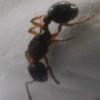2. Date of collection: 4/21/15
3. Habitat of collection: sandy/wooded
4. Length (from head to gaster): 9mm
5. Color, hue, pattern and texture: Mostly black
6. Distinguishing characteristics:
7. Anything else distinctive:
8. Nest description: unknown
Edited by dspdrew, April 21 2015 - 8:42 PM.
Fixed video link
















